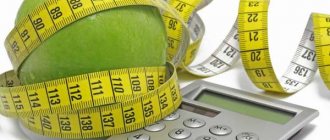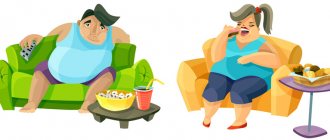Calorie content - what is it, how is it measured?
If you re-read a physics textbook, you will not be able to find the official term; it was not included in the International System of Units of Measurement, but was invented by a scientist studying physical processes - Johann Wilcke. He called the word “calories” or abbreviated “cal” the amount of heat that is required to heat 1 ml of water by 1 degree. Then this designation is transformed and in the minds of ordinary people and biologists, nutritionists is perceived as the energy of food (although it is classically measured in kilojoules - KJ), necessary to maintain vital functions in the body.
During various body movements, during internal processes (breathing, heartbeat, digestion of food), and in large quantities during mental activity, these same calories are consumed.
When there is a surplus, that is, an excess, a situation occurs when the body stops processing food (namely the BJU contained in it) into heat, since it is not needed in such quantities, and the body begins to put aside proteins, fats and carbohydrates “in reserve” , that is, turning them into a fatty layer.
To lose weight, you need to create conditions of deficit, that is, you must receive less kcal than you expend. The deficiency will be compensated from the same supplies, that is, lipids will be transformed. This process works best during aerobic exercise - calorie burning can be accelerated by running, intense aerobics, cycling, skating, skiing, and long (from 30 minutes) jumping rope.
The second term is the calorie content of food separately and prepared dishes. This question is of great concern to those who want to lose weight and are on a diet. They limit their intake of high-calorie foods. This is the maximum energy that the body takes from one serving, subject to complete absorption. It is worth noting that in fact, food is never digested and absorbed into the blood completely, there is always waste, and this is also prevented by various diseases and situations (indigestion, fast or slow intestinal motility, the absence of some villi on the gastrointestinal tract, etc.).
For comparison, a glass of water has 0 calories, a 100-gram piece of red apple has less than 50, and 100 grams of milk chocolate has 500 or more. So a kilogram of apple fruits can be nutritionally equivalent to one sweet chocolate bar.
Another question is how much of the maximum possible energy the body will receive and how quickly it will do it.
So before you know how many calories running burns, you need to think about how much you take in (eat) during the day. This can be calculated based on the packaging of store products.
Why is there scattering and unevenness in calorie consumption?
The scatter is associated with biological processes occurring in the body. First of all, food is digested. Only after 20-25 minutes do fat reserves begin to break down.
The amount of energy spent also depends on the type of activity. Jogging will allow you to burn more calories than sprinting due to the duration of the impact. However, if you alternate between medium and high speeds, the effect will be better than training in one speed mode.
There are several types of running:
- Jogging (the most common, often used to burn excess fat);
- Sprint (intense load, high speed, recommended to be combined with moderate activity);
- Interval (alternating speed modes, great for losing weight);
- Running uphill or up stairs (uses other muscle groups, trains endurance, helps burn fat).
See the same topic: Can I eat Korean carrots on a diet?
The absorption and burning of energy reserves is influenced by the characteristics of the body. Proteins, fats and carbohydrates are absorbed differently. Individual factors also influence this process.
For everyone, the process of breakdown of macro- and microelements occurs in accordance with the structural features and biological capabilities.
Calorie production in the human body
Why are we talking about this? So that you understand where the legs grow from, because this process works in two directions - to receive heat, and then to release it during sports activities.
When food is consumed, a mass containing bound fats, proteins, carbohydrates, vitamins and microelements (calcium, phosphorus, etc.), and water enters the digestive tract. Under the influence of stomach secretions (acids and salts), all this is broken down into the smallest elements. Most vitamin elements are absorbed by the intestinal walls into the blood, as is part of the BJU. The rest remains undigested to the end, or rather, not assimilated, that is, it does not bring any benefit.
The reaction of the breakdown of bound microelements into chemical particles occurs with the release of heat (those are our kilocalories!). Most of it goes away through natural processes - to heat the body in the cold season, to sweat. The second part is transformed into ATP molecules, or otherwise, into adenosine triphosphate. This is one of the most important elements in the body of all mammals, because most stages (fermentation, movement, the formation of muscles, fats and even mental activity) occur thanks to and with the involvement of this nucleic acid.
Warmth is necessary for physical and mental exertion, but if there is not enough of it (an ordinary person, during sedentary work, consumes more than he expends in a day), then unspent ATP is deposited throughout the body in the form of fat. Molecules are thrifty storekeepers who try to hide as much as possible for a rainy day. The place where the main fat will be concentrated (problem areas, usually the sides and buttocks in women, the stomach in men) depends on the body type and is genetically predisposed.
And the particles that break down into their component parts are used for muscle regeneration, replenishment of lost cells, hematopoiesis and other daily tasks of the body.
If you don’t want to gain weight or count the calorie content of each bite you swallow, it’s better to calculate your daily intake and, taking into account how many calories are consumed when running, give yourself 20-30 minutes daily for jogging.
The effectiveness of running for burning calories
The higher efficiency of running for burning calories compared to all kinds of weight loss products and diets for eliminating fat is obvious. This is due to the fact that running, in addition to making it possible to eliminate excess weight, promotes health, increases endurance, improves the functioning of the cardiovascular system, accelerates blood circulation, and increases muscle tone. Running contributes to the formation of a beautiful figure, since it is when running that the load is distributed evenly across all muscle groups. The body becomes trained and harmoniously developed.
As a result of jogging, the metabolic process accelerates, which allows running to be characterized as the most effective means for losing weight and burning unnecessary calories. This is especially true for problem areas of the body such as the buttocks, abdomen and legs. People who practice morning jogging significantly reduce the risk of getting cellulite.
Moreover, the more a person weighs, the more calories he spends when running. How many calories does an obese person burn when running? For example, with a weight of 90 kg, a person will spend about 750 kcal per hour of training, while our example with a woman weighing 70 kg shows that she lost about 600 kcal during an hour's run. The difference is significant. But for people who are too overweight, a large loss of calories when running is not yet an indication for using this method for losing weight. For obese people, running is contraindicated because the risk of injury to the joints of the lower extremities is high. The fact is that with a sufficiently large body weight, running puts too much pressure on the knee joints and feet, which can result in serious damage to tendons and ligaments. People with a body weight of more than 90 kg are not recommended to lose calories while running - less is provided for them traumatic weight loss programs.
How to combat excess heat with running exercises
With short cardio workouts, you can achieve good results in terms of removing excess water (drying), strengthening the heart muscle and musculoskeletal system, but losing weight in 5-10 minutes a day is virtually impossible. This is explained by the fact that during training, the muscles only warm up during the first time, and only after 10-15 minutes they begin to actively break down carbohydrates. But the task of losing weight is the breakdown of fat, which occurs only after 25-30 minutes.
On average, when calculating for a person aged 20-45 years, we can answer the question of how many calories can be burned when running - 12-13 kilocalories per minute. This figure is suitable for the stronger sex; for women it is 15% less due to the structure of the body. The female body as a whole is more adapted to storing fat for pregnancy, so it “gives off” heat much more reluctantly.
How does distance affect
The average speed to cover one kilometer is 6-7 minutes, at a high pace - 5. Such a short kilometer warm-up will “cost” you 200-250 kcal, which you will gain back at the first snack. The longer the route, the greater the effect. But remember three rules:
- start with short sessions, gradually increasing them;
- every cardio workout starts with stretching;
- If you have a large body weight, first take long walks, gradually speeding up.
A good distance for beginners is 2-3 km, for intermediate ones – from 5 to 10 km. You need to focus, first of all, on your own well-being.
How many calories are burned during different types of running?
For weight loss, the best option is jogging or brisk walking, this allows you to maintain a continuous load for a long time. Sprinting, that is, maintaining a speed interval of 15 to 20 km/h, is not compatible with long training, so acceleration can only be used occasionally. If you cannot maintain constant tension, you can alternate it with walking, but do not stop completely. So a scheme of 10 minutes of jogging and the next 10 minutes of walking with alternations for an hour will also help to effectively get rid of 300 - 350 kcal.
Moving on flat terrain
A straight surface is most comfortable for leisurely running. Specially equipped stadiums, walking paths in the park or a treadmill in the gym or at home are suitable. The advantage of this type:
- the choice of speed limit depends on you, not on the terrain;
- you don’t have to worry about coordinating movements, they are all uniform and identical;
- the step amplitude is constant;
- It’s easy to calculate the load on the body and the result depending on the duration and speed.
How many calories are lost when running up stairs or uphill?
In this case, the angle of inclination (on a treadmill this indicator is set manually), the choice of terrain, as well as the width and height of the steps are important.
Please note that stair trainers are installed only in one direction - uphill. This is due not only to the fact that the kcal consumption is higher, but also to the fact that during the descent you can damage your joints and get a sprain. For this reason, we do not recommend running up and down regular stairs in your home.
More energy is consumed, since movements need to be made more sweepingly (lifting the leg), and the muscles are under greater stress. For a man with average training and weighing about 70 kg, consumption for 10 minutes is 170 kcal, and for an hour - all 1070.
Features of jogging
Proper jogging implies a jogging speed of 7-9 km/h, that is, a little faster than regular active walking. However, it has its own characteristic features of the technique: “spanking” with a relaxed foot, or, on the contrary, a hard blow with the heel on the support. The main difference between this type of running is that it has a shorter flight phase, that is, the period of state without support is almost absent: when one leg pushes off the ground, the second just touches the surface.
Professional athletes often use running training to warm up. This type of exercise is also good after injuries as a restorative activity. Since proper jogging puts less pressure on your joints than regular running exercises, your risk of injury is reduced.
Athletes claim that this type of physical activity, provided it is of good duration (30 minutes or more), has a remarkable effect - runner's euphoria, which is accompanied by a feeling of happiness, an uplift in mood and a feeling of lightness.
Balancing calorie intake and expenditure
We will present heat standards for men and women depending on the degree of physical activity. They are typical for those who want to stay at their weight. If you want to lose weight, then you need to create a deficit - either consume less (but this can affect the lack of microelements and vitamins), or spend more. The numbers are indicated in the calculation - kcal per day.
| Floor | Lack of sports, sedentary lifestyle | Light exercise, walking | Sports training at a medium pace | Vigorous physical activity |
| Male | 1300-1500 | 1500-1700 | 1800-2000 | 2000-2400 |
| Female | 2000-2200 | 2300-2400 | 2500-2800 | 2900-3200 |
How many calories does an hour of running burn: several ways to calculate
You will need a calculator (you can find programs online), the second option is to use our formulas. Please keep in mind that the results are approximate as they depend on many factors.
What is taken into account when calculating
Key indicators that help increase kcal consumption:
- speed - the more intense the movements, the more energy is required for them;
- duration;
- Your own body weight is a natural “weight”; for fat people, long distances are more difficult; you should start with fast walking, then go jogging.
Does running help you lose weight?
By doing regular running training, the body gradually becomes toned. This allows you to achieve maximum fat burning effect.
I read an opinion that a girl stopped running because her legs became large from growing muscles. Having communicated with a large number of athletes, including marathon runners, I have never met a girl with unattractive legs due to large muscles. Although they have been practicing regularly for many years! To make your legs really big, running alone is not enough. It is necessary to purposefully work out in the gym while using chemicals.
Achieving an attractive figure occurs gradually, and each workout makes the body a little slimmer. Having decided that the figure has become ideal, you can reduce the amount of load. Time to achieve results is from 1 month.
The time to achieve results depends on your goal. If your weight is normal, but you want to tighten your hips and reduce your belly, 1 month is enough. Fighting excess weight requires more time and effort, but the results are worth it.
Several ways to calculate calories burned
Let's present 4 popular options.
We trust statistical research
The average value is about 500 kcal/hour. For a more detailed answer, you should familiarize yourself with the proposed indicators, which depend on gender and method of training.
Table 1. The first theory - statistics
| Activity | Woman | Man |
| Quick step | 240 | 320 |
| Jogging | 500 | 660 |
| Climbing stairs | 900 | 1500 |
| Uphill | 650 | 870 |
| With accelerations | 900 | 1150 |
Apply the formula
K = M*D, where:
- K – kilocalories.
- M – weight, kg.
- D – distance, km.
An example for a girl weighing 50 kg who ran 10 km.
K = 50*10 = 500 kcal.
This is subject to average air temperature (neither hot nor cold) and flat terrain.
Take a calculator
Various services have formulas in which you only need to enter the necessary parameters; information may be required:
- body weight;
- Kind of activity;
- speed;
- time;
- distance.
Example:
A 50 kg girl exercises for 60 minutes at a pace of 8 km/h and consumes 423 kcal.
But you can use ready-made calculations
Table 2. How many calories are burned while running in 1 hour at different speeds
| Speed/Body Weight | 50kg | 55kg | 60kg | 65kg | 70kg | 75kg | 80kg | 85kg | 90kg |
| 3km/h | 126 | 138 | 150 | 163 | 175 | 187 | 201 | 213 | 226 |
| 4km/h | 160 | 177 | 192 | 209 | 224 | 240 | 257 | 272 | 288 |
| 5km/h | 184 | 202 | 221 | 239 | 258 | 276 | 295 | 312 | 331 |
| 5km/h | 217 | 238 | 262 | 283 | 304 | 326 | 349 | 369 | 392 |
| 7km/h | 291 | 321 | 351 | 379 | 409 | 439 | 467 | 496 | 526 |
| 8km/h | 374 | 410 | 449 | 487 | 523 | 562 | 598 | 636 | 673 |
| 9km/h | 480 | 530 | 577 | 625 | 674 | 722 | 769 | 818 | 866 |
Table 3. Average time for a certain distance
It is difficult to maintain constant acceleration, so the first lap is easier, the subsequent ones slow down. The data is relevant for a man, 70 kg:
| Distance, km | Time, min | Consumption, kcal |
| 1 | 6 | 74 |
| 5 | 35 | 431 |
| 10 | 70 | 862 |
Watch your heart rate
Buy a heart rate monitor, this device is worn on your wrist, it will help you monitor:
- Heart rate;
- time;
- speed;
- the number of kilocalories spent.
What influences the effectiveness of training
Additional factors that contribute to accelerated lipid burning:
- Outside air temperature. The warmer the athlete is, the faster the process occurs through intense sweating. In winter, it is recommended to wear special tracksuits that maintain a comfortable temperature. Stayer offers excellent models. The brand creates winter sports equipment that holds heat well without creating a vacuum effect.
- Alternating tempo. Adjusting your step, increasing and slowing your heartbeat, etc. also requires additional energy.
- Additional movements. They can be done with your hands (swings, circular rotations) or with your feet, raising your knees or overlapping your shins.
- Climb the hill. The steepness of the climb directly determines how many calories are burned when running. A similar exercise is the ladder.
Use these tips to lose weight and strengthen your heart muscle.
Recommendations for Beginners
Here are the rules that coaches give to novice athletes:
- Don't forget about your hands. Their movement should be in rhythm with their feet. In addition, this increases energy consumption.
- Start with a slow pace or even a fast walk, and gradually increase your speed.
- Don't look at your feet, just forward. This promotes proper body posture.
- Step on your entire foot, rolling from heel to toe.
- Do not clench your fingers into fists; on the contrary, relax your hands and shake your hands periodically.
- Turn on the player and suitable music - this will help you get into a good tempo, and also relax, and not think about the time spent at the stadium.
- Exercise in the morning before a hearty breakfast, and also look for places with good fresh air, away from the roads.
- Always start with a warm-up and end with a cool-down - stretching, slow walking.
You should exercise 3-5 times a week.
Basic rules for running to burn calories
- Alternating loads. The body gets used to constant training and burning calories when running slows down. It is necessary to include cross-country running, jumping rope, sprinting and long jump in the training program;
- Proper nutrition for weight loss. For optimal calorie loss when running, training alone is not enough; you must adhere to a balanced diet, which will help burn fat deposits more effectively;
- A smart approach . When performing power loads on the body, you cannot do without this rule - reasonable prioritization and proper scheduling of exercises is the key to not only successful weight loss, but also maintaining health in general. Increase your loads gradually, listen to your feelings, and losing calories while running will be effective and smooth.
Experts advise running no more than 3-4 times a week. They explain this by the fact that when running there is such a strong “shock” for the body that it is impractical to withstand such a load every day. For optimal calorie burning when running, you should train in the morning - then the load occurs with double force and the effect is achieved faster (see Benefits of running in the morning
). However, there is a lot of controversy on this topic: doctors do not recommend morning running due to the high risk for blood vessels, since in the morning all body systems have not yet entered the “working” rhythm. The risk of having a stroke and other possible consequences of such overloads is too great.
The best option for losing weight is running in place. It is performed at any time of the day and does not load the body as much as regular jogging. When running in place, you lose a little less calories, but if you follow certain rules, you can achieve excellent results.
To accurately calculate how many calories are burned when running, you can use special tables. To do this, you need to know your exact weight and take into account the duration of your training. If you experience the slightest discomfort (headache, abdominal pain, etc.), you must immediately stop exercising and consult a doctor. People with hypertension, heart disease, disorders of the cardiovascular system, pulmonary patients and people with bronchial asthma should not run. Based on materials from vesvnorme.net, drdobrov.com
See also:
What burns fat better: weights or running?
Running: the most affordable way to lose weight
The main rule of training is to pay attention to your equipment.
For summer jogging, you should always wear a hat; failure to wear one can lead to sunstroke or heatstroke. The fabric of a tracksuit should be well ventilated and not compress the body. Shoes – sneakers with good cushioning.
In winter, buy special winter sports clothing. The Stayer company offers excellent models - durable, wear-resistant and stylish overalls, as well as trousers with a jacket, are suitable not only for running, but also become excellent equipment for snowboarding and skiing.
How to run to lose weight?
To summarize: if you run calmly, you will burn fewer calories in the same amount of time, but they will be spent primarily from fat. If you run fast, more calories will be burned, but their source will be glycogen reserves in the muscles and liver, and after such a workout the calories will be “burned off” for some time. At the same time, it is important to understand that it is simply impossible to constantly train in a high-load zone, since the body will not have time to recover, which will lead to overtraining and injuries.
Thus, the optimal option for constructing the training process would be to alternate loads of different intensity. This will allow the runner to recover, and will also help avoid the habituation effect, when the body adapts to the same type of loads, and their effectiveness decreases.










